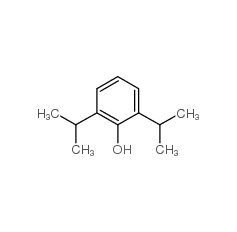All AbMole products are for research use only, cannot be used for human consumption.

Propofol inhibited tumor size, cell viability and promoted cell apoptosis via inhibiting mTOR/p70S6K pathway mediated by HOTAIR in cervical cancer. In present study, we found propofol markedly decreased the HOTAIR expression of cervical cancer cells in a dose-dependent manner. In vitro experiments, we found HOTAIR overexpression promoted cervical carcinoma cells growth and inhibited cell apoptosis after the treatment of propofol.
| Cell Experiment | |
|---|---|
| Cell lines | Caski cells |
| Preparation method | 1 × 10^4 cells/well HeLa, CaSki and C33A cells were plated incubated in 96-well culture plates at 37℃ for 24 h, and then co-cultured with different concentrations (0 μg/ml, 1 μg/ml, 5 μg/ml and 10 μg/ml) of propofol for another 48 h. |
| Concentrations | 10 μg/ml |
| Incubation time | 48 h |
| Animal Experiment | |
|---|---|
| Animal models | C57BL/6 mice |
| Formulation | soybean oil |
| Dosages | 50 mg/kg |
| Administration | i.p. |
| Molecular Weight | 178.27 |
| Formula | C12H18O |
| CAS Number | 2078-54-8 |
| Form | Melting point 18°C |
| Solubility (25°C) | DMSO ≥ 60 mg/mL |
| Storage | 2-8°C, sealed |
| Related GABA Receptor Products |
|---|
| β-CCB
β-CCB is a ligand for benzodiazepine receptor, which inhibits the binding of [3H]flunitrazepam and ethyl (3-[3H]carboline-3-carboxylate to benzodiazepine receptors, with Ki of 3-4 nM. |
| TPMPA
TPMPA, a hybrid of isoguvacine and 3-APMPA, is the first selective antagonist for a GABAC receptor (KB = 2.1 μM), but not to interact with GABAA (KB = 320 μM) or GABAB receptors (EC50 = 500 μM). |
| CI-966
CI-966 is a potent, selective, orally active and brain-penetrant inhibitor of the GABA transporter GAT-1, with IC50s of 0.26 μM and 1.2 μM for hGAT-1, rGAT-1, respectively. |
| NCS-382
NCS-382 is a potent GABA receptor antagonist and also a GHBR receptor antagonist. |
| CGS 8216
CGS 8216, a benzodiazepine receptor antagonist, inhibits 3H-flunitrazepam (3H-FLU) binding to rat synaptosomal membranes in vitro at subnanomolar concentrations. |
All AbMole products are for research use only, cannot be used for human consumption or veterinary use. We do not provide products or services to individuals. Please comply with the intended use and do not use AbMole products for any other purpose.


Products are for research use only. Not for human use. We do not sell to patients.
© Copyright 2010-2024 AbMole BioScience. All Rights Reserved.
